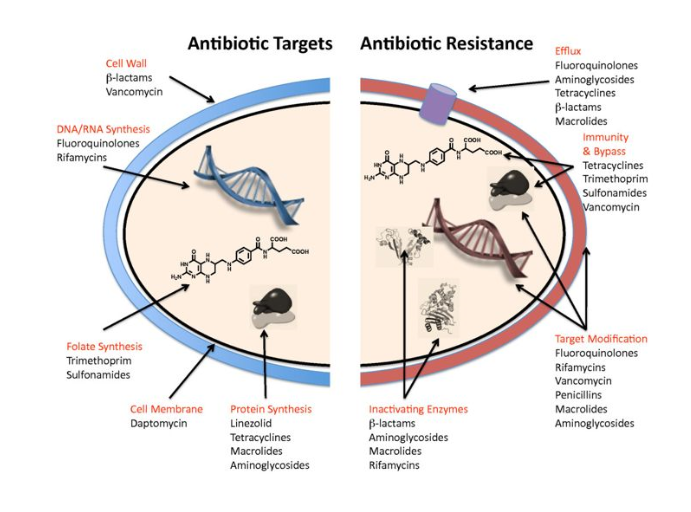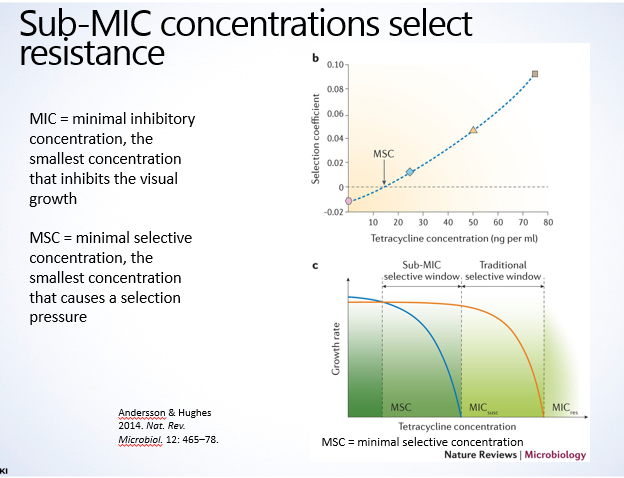Table of contents
3) Key concepts
3.1 Policy context
The European One Health Action Plan against AMR was launched in 2017[1]. The Plan acknowledged the environment as a contributor to the development and spread of AMR in humans and animals, but that strong evidence was required to better inform decision-making.
In the European Union (EU), the legislation governing urban waste water treatment is largely set by the Urban Waste Water Treatment Directive (91/271/EEC) (UWWTD), which requires certain levels of treatment depending upon the size of the population being served and the sensitivity of the waters into which the effluent is discharged. The aim of the UWWTD is to protect human health and the environment, with requirements for reduction in of organic matter, nitrogen and phosphorus (but not bacteria). The Bathing Water Directive (2006/7/EC) (BWD) applies where waters are designated for bathing and sets bacteriological standards for the water, which may require additional treatment at UWWTPs. The overarching Water Framework Directive (2000/60/EC) (WFD) provides a common approach to managing European waters and includes both the UWWTD and BWD as “basic measures” towards achieving the objective of good status in all waters. A strategic approach to pharmaceuticals in the environment is being developed by the European Commission under the Environmental Quality Standards Directive (2008/150/EC) as a daughter of the WFD. At the time of the meeting, both the WFD and the UWWTD are undergoing evaluation to assess whether they are delivering as intended and whether there are gaps in the legislation.
3.2 Microbial ecology and antimicrobials
There is an enormous number of microorganisms on earth and they form a vital part of a healthy ecosystem. Antimicrobials are medicines used that treat infections caused by microorganisms such as bacteria, fungi, viruses, and parasites.
AMR is a natural phenomenon that has evolved over evolutionary time, but also develops rapidly when microorganisms are exposed to antimicrobial drugs (such as antibiotics, antifungals, antivirals, antimalarials, and anthelmintics). New resistance mechanisms are emerging and spreading globally, threatening the ability to treat common infectious diseases, resulting in prolonged illness, disability, and death. Without effective antimicrobials for prevention and treatment of infections, medical procedures such as organ transplantation, cancer chemotherapy, diabetes management and major surgery become very high risk (WHO, 2018)[2].
One type of AMR, specifically antibiotic resistance is an ancient phenomenon and even samples from permafrost, “pre-Antibiotic era” show resistance genes against modern antibiotics. There are two basic types of resistance: i) Intrinsic, where the resistance is usually related to structural features of the cell; ii) Acquired, where resistance is caused by mutation or acquisition of novel genes which can happen via a variety of mechanisms, together termed “horizontal gene transfer”.
Figure [A] shows various ways in which antibiotics work (“antibiotic targets”) and ways in which resistance may be generated. Antibiotics work by interfering with enzymes involved in forming the cell walls, nucleic acid metabolism and protein synthesis, or by disrupting membrane structure, for example. Resistance mechanisms include reducing the amount of antibiotic taken up or increasing the amount expelled, producing non-sensitive enzymes, changes (“mutations”) to the target site, or changes to the antimicrobial itself.
Fig [A]: Antibiotic targets and mechanisms of resistance.

Source: Wright, GD, 2010 https://doi.org/10.1186/1741-7007-8-123
Resistance is part of evolution. It occurs when the bacteria are subjected to a pressure that has the effect of selecting individuals that can resist that pressure. Those that are resistant tolerate the pressure better than those that are not, and go on to parent successive generations. For urban waste water treatment, microorganisms provide an important ecosystem service at the treatment plant. Able to resist the range of pollutants that enter, they can break down the organic matter in the effluent. As antimicrobials form part of that influent, it is a natural process that causes some microorganisms to resist the bactericidal action. Once developed, resistance genes can be transferred between microorganisms, though in the environment there is also the possibility for resistance to occur through natural processes.
Pressures that select for resistance include antibiotic residues as well as contaminants like some metals. Traditionally, the smallest concentration that causes a selection pressure was considered to be the “minimal inhibitory concentration” (MIC) which inhibits growth of susceptible or non-resistant bacteria. More recently, the importance of the “minimal selective concentration” (MSC) has been recognised. This is the lowest concentration at which a selection pressure may have an effect on the relative growth rates of resistant and susceptible bacteria, and can be several times lower than the MIC. (Fig [B]).
Fig [B] Concentrations above the minimum selective concentration select for resistance.

3.3 Urban waste water treatment
Urban waste water treatment protects surface waters from the adverse effects of waste water discharges, such as organic pollution, the associated development of bacteria and fungi, and oxygen depletion, which degrade aquatic life. This is achieved through the collection and treatment of waste water in settlements and areas of economic activity. The installation of waste water treatment facilities first requires a sewage collection system be established and then the provision of facilities to treat the collected waste water. “Primary treatment” refers to simple sieving of the effluent, to remove large objects, before discharge into the environment. “Secondary treatment” subjects the effluent to microbiological breakdown to reduce the oxygen demand on the receiving water. More stringent or tertiary treatment may be applied where the receiving water is particularly sensitive, and there is a need to substantially reduce nitrogen and phosphorus concentrations, for example. Disinfection techniques, such as ozonation, chlorination or UV treatment, may be applied to reduce the bacterial load, for instance to protect bathing waters. Typically, higher levels of treatment will involve higher costs, owing to higher energy and infrastructure costs.
Collection and sewerage systems are built to deal with a maximum capacity. Heavy rainfall can exceed the capacity in systems combining both household and surface drainage, so “storm water overflows” enable the excess, untreated effluent to be directed to rivers etc., bypassing sewage treatment.
Application of sewage sludge to land is an important destination for large quantities of organic material, acting as a fertiliser and improving soil condition. In this way, it contributes to a circular economy, but may represent another way for AMR to be spread into the environment.
Urban waste water treatment significantly reduces the numbers of bacteria in sewage. This reduction is most important in limiting the numbers of resistant bacteria. While secondary treatment reduces the bacterial load, further intensive treatment such as disinfection using UV oxidation or chlorination is needed for significant destruction of microorganisms.
3.4 Protection Goals
Protection goals specify what to protect, where to protect it and over what time period. At this stage, protection goals for AMR in the environment are unclear.
The precautionary principle, enshrined in the Treaty of the Functioning of the European Union, underpins the approach to policymaking when an environmental or human health hazard is uncertain and the stakes are high[3]. Such is the situation with AMR and the environment.
There is a long history of regulating chemical compounds in the aquatic environment. In the current context, environmental quality standards under the Water Framework Directive provide a useful model for monitoring concentrations of antibiotics in water, while monitoring fecal indicators under the Bathing Water Directive provides one for microbiological pollution.
Environmental quality standards set a concentration of a particular chemical that should not be exceeded in a water body. The standard is set based on the toxicity to the most sensitive species in a range from algae, through invertebrates, to fish and predators like otters, birds or humans. The toxicity assessment considers the predicted no effect concentration (PNEC) i.e. that at which no adverse effects are expected. It is similar in concept to the MSC used in microbiology, though the MSC is the lowest concentration at which selection pressure may occur.
Setting environmental quality standards for antibiotics is difficult, because currently there is limited toxicity information available. A PNEC is only available for about 20 out of a total 111 antibiotics, and for a very limited range of species. Setting quality standards without information for an adequate range of organisms can lead to conservative risk factors, which may produce very challenging standards with limited supporting evidence.
Good bathing water quality is achieved if the 95th percentile of all samples at the site in the most recent assessment period is lower than defined limits of intestinal enterococci and E. coli[4]. Limits are set for the number of colony‑forming units in a set volume of water, with lower limits for coastal and transitional waters than inland waters.
For limiting the release of antibiotics themselves in the environment, quality standards for concentrations in water would be relevant both to effluents released during manufacture, and to those from UWWTPs where the substance has been neither metabolised nor degraded during treatment. Reducing the concentrations of antibiotics in the environment from manufacturing relies on good practice to control releases, with a theoretical limit of zero releases. Those arising from medical or veterinary use however, can only be limited to “necessary use”.
For AMR in the environment, various protection goals can be envisaged, depending upon the aim of the monitoring programme. Examples are:
- Limiting the levels of antimicrobial resistance genes (ARGs): This treats genetic determinants for resistance as pollutants;
- Setting activity-based assessments: For example, antibiotic residues tests for food and drink;
- Limiting the number of cefotaxime resistant E. coli: This builds upon existing bathing water standards by looking at resistant enteric (intestinal) microorganisms;
- Limiting concentrations to thresholds determined by Minimal Selective Concentrations (MSCs): Similar in concept to environmental quality standards.
3.5 Environmental elements of European Commission R+D funding for AMR
The EU One Health Action Plan, launched in 2017, aims at making the EU a best practice region on AMR[5]. It commits to closing knowledge gaps on AMR in the environment and on preventing transmission. In an international collaboration, the Joint Programming Initiative on Antimicrobial Resistance (JPIAMR) supports One Health research.
The EU Horizon 2020 work programme for 2018-20 commits nearly 200mEuro to AMR, and there are industry and joint industry-government initiatives to address AMR. Via ERA-Net co-funding the Commission supports 7 research projects studying environmental aspects of AMR including:
- the dynamics of AMR in the urban water cycle;
- the processing of waste water and sludge;
- the study of environmental sources of resistant clones;
- the transmission of resistance affected by ecological variables including environmental, food and wastewater contamination.
[1] https://ec.europa.eu/health/amr/sites/amr/files/amr_action_plan_2017_en.pdf accessed 03/12/18.
[2] http://www.who.int/en/news-room/fact-sheets/detail/antimicrobial-resistance accessed 03/12/18.
[3] http://www.europarl.europa.eu/RegData/etudes/IDAN/2015/573876/EPRS_IDA(2015)573876_EN.pdf accessed 25/02/19.
[4] https://www.eea.europa.eu/publications/public-health-and-environmental-protection accessed 25/02/19.
[5] https://ec.europa.eu/health/amr/antimicrobial-resistance_en accessed 25/02/19.


